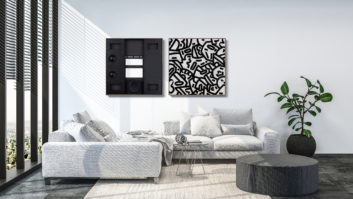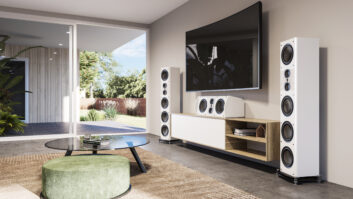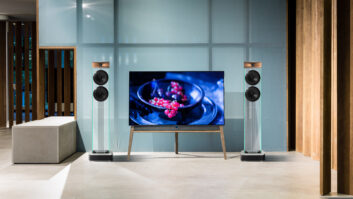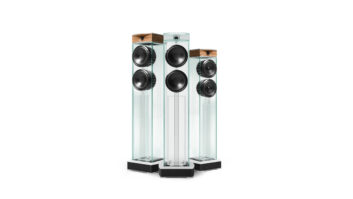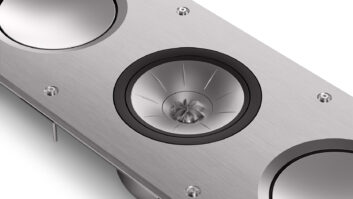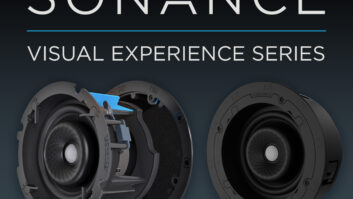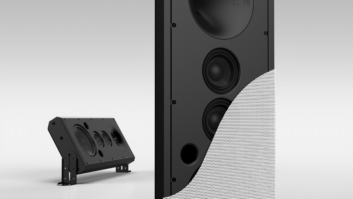Recently, Kevin Burnley, owner of Creative Audio Video and Automation in St. Louis, MO, got a dream project: a large, new construction home ready to be kitted out with 14 zones of high-quality, high-output audio. Working with existing clients, the new project required Burnley’s team to delivering specific volume levels and even coverage while maintaining a clean look to the installation.
“In this home, we had the freedom of providing the correct amount of speakers (two to six, depending on the room size) and in-ceiling subwoofers to get them the level and fullness they were looking for,” Burnley noted. “We were happy to even get a subwoofer in the master bathroom ceiling this time, along with TDG Audio NFC 63s. This design provided the volume level needed, plus we added the optional square grill kits to blend with the modern can lighting.”
Creative Audio Video and Automation went on to install a blend of TDG NFC 82s and NFC62s to fill the home with great sounding audio and continue with the discreet integration of square grills to blend with the home décor, as well as incorporating Control4’s Airplay feature to allow wireless streaming and multiroom playback on a robust Wi-Fi network, also installed by the team.
This successful audio integration project by Burnley and his team underscores why in-wall/ceiling speakers continue to play a significant role in the evolving residential systems integration landscape, one that now requires custom integrators to thoughtfully blend a host of new technologies (IoT, streaming audio, IP networking, voice control, etc.) that consumers have come to see as necessary for a modern entertainment experience. Architectural speakers, long the go-to options for clients looking to preserve the aesthetic integrity of their home, have continued to thrive, even as audiophiles decry their ability to deliver what they believe to be the best sound quality—grumblings that have found less veracity as speaker quality and design have steadily improved.
“As an integrator, high-performance sound bars and enclosed performance speakers are definitely exciting,” said Lee Travis, owner of Bellevue, Washington’s Wipliance, a Triad Speakers dealer. “We basically went through what I would call “audio sinning”—compressing music to make it accessible—and now, as we make that move to hi-res sources like with Control4 systems, people are falling in love with the sound quality, not just the ease of use. People care more about sound quality. It’s a move toward higher quality audio because the sound is just better, and people want architectural look with high-performance sound.”

Among the driving factors in this reinvigorated channel, is voice control, thanks in large part to consumers embracing readily available solutions from giants such as Amazon and Google. It’s a solution that Neil Wiessler of Shore Sound & Cinema uses in combination with Origin Acoustic’s Valet amplifier and Amazon’s Echo Dot.
“Origin Acoustic’s release of the Valet amplifier along with the integration of hiding Amazon’s Echo Dot in the ceiling is simply amazing,” Wiessler said. “The Valet system can provide a multi-room background audio system solution without the overhead of a sophisticated control system. It’s just a cool solution to multi-room audio using technology that clients are already familiar with.”
Weissler’s take that voice control (or as he calls it, voice recognition) is advancing in both the IoT and AV space also bares out in his in-field experience, where he notes that his team is often asked about integrating Alexa and Google Home into their control systems.
“The Xfinity Voice Remote is ubiquitous with voice recognition, and now everyone assumes we should all be able to speak to our remotes,” Wiessler explained. “While Alexa may handle VR easily when it comes to its own integrated apps, using Alexa to operate a control system is still hit or miss… [clumsy] best. Today’s VR interfaces do not handle natural speak well when it comes to control systems and teaching a client to speak in syntax is a disaster. I am optimistic, but I feel natural speak VR is still a few years out.”

New tech integration and kinks aside, sound delivery remains paramount. Across the board, integrators are reporting that sound quality partnered with continued respect for interior design concerns underpin their in-wall/ceiling speaker choices. TDG Audio dealers David Monaghan of Myriad Entertainment Solutions and Matthew Lucchetti of Federal Hill Home Theaters (FHHT), both value the bezel design of that manufacturer’s range of architectural speaker options while favoring the sound output, which Lucchetti compares to a high-end tower speaker.
“FHHT’s go-to system format is a 7.2.4 Dolby Atmos utilizing TDG in-wall/ceiling speakers and subwoofers,” Lucchetti added. “We love the 3D audio aspect of the Atmos format. And the TDG line allows us to put speakers exactly where we want them for each unique application, while keeping a modern look and an amazing sound quality.”
Federal Hill Home Theaters recently completed an install using TDG’s full roster of speakers, a Denon AVR, and HEOS links. In the living room the team went with the TDG Signature Series of in-walls for fronts of the Dolby Atmos system and used 8-inch in-ceilings in the exterior deck overhang because of their back boxing and rust-proof grills. Most challenging for the team? The master bedroom ceiling and its two layers of drywall.
“The TDG ‘Double Dog’ allowed us to quickly and efficiently install the speakers there,” Lucchetti said. “TDG’s STT speaker allowed us to continue the ease of installation into the walk-in shower as it was humidity-proof. Throughout the entire home we incorporated a HEOS system with 11 zones, plus a very significant TDG outdoor audio in the process for the spring.”

Sound quality and delivery also dictates The OPP Group’s Alfred Al-Tee Williams’ choice of Beale Street Audio kit. A professional audio engineer and integrator, Williams is also a fan of integrating voice and home control in his audio system projects.
“Beale Street Audio is my go-to in-wall/in-ceiling speaker system because the speaker’s unique patented sonic vortex technology allows an integrator to install the speakers in any location without sacrificing sound,” Williams noted. “Beale Street’s speakers are straight forward and easy to install, making the integrators job easy.”
To highlight why Beale Street Audio works best for his projects, Williams recently tackled a fireplace with a recessed ceiling. With a client request to integrate high SPL level speakers, OPP integrated BSA speakers and Amazon Alexa for audio streaming. “The biggest challenge was placement because of the structure of the building and foam installation,” Williams added. “Beale Street speakers made the job easier. We were able to cut out the foam on the rear right speaker to accommodate the space and maintain a consistent sound over a large area.”
Making Installs Easier
In-wall/ceiling speaker solutions, by their nature, require a bit of hard work to install; embedding anything into a wall can get messy. It’s one aspect of the job that integrators are looking to manufacturers for innovation and improvements, with Monaghan and Burnley calling for a continued evolution of “the design for simple and efficient installation.”
Another is the footprint of the speakers themselves. In-walls/ceiling speakers, though hidden, can still be too big and clunky, which is fine in a new build, but the also thriving MDU market fueled by a younger, more tech-savvy apartment buyer, might not have the luxury of cutting large holes of speakers. It’s a specific problem that Travis faces in his Seattle base.
“Architectural speaker manufacturers can improve the category by adding higher performance in smaller footprints,” he explained. “In the Seattle market, hi-rise MDUs and apartment buildings don’t have the space, so smaller speakers would be good. We’re able to get everything smaller with technology so that makes sense.”
Design of woofers also coming into play. Though not touched on much by our integrators, integrating in-wall sub-woofers like those produced by companies like JL Audio and Origin Acoustics still remain a challenge, even as that, too, becomes easier. And while Williams would love to see smart self-powered in-wall speaker systems hit the market, Lucchetti envisions a redesign influenced by the home theater market.
“The near-future technology that we see having a large impact on the continued growth is the ability of in-wall speakers to have separate woofers for the front or rear height channels to help with the expansion of 3D audio formats,” Lucchetti said.
Still, voice control, with its glitches and growing pains, remains the most sought after and influential factor in what custom integrators expect to hear from their clients most in the near future.
“Building on the voice control feature, it would be cool to see the ability to incorporate an Alexa microphone into the built-in speakers allowing a client to communicate with Alexa from any room in the residence from a seemingly invisible source, the audio system could act as the speaker for Alexa’s voice,” he said. “Just a thought.”
Wiessler is more pragmatic on this score, citing resistance from “certain streaming hardware companies and streaming source companies” to play well with the CI channel. Calling the stance “draconian,” Wiessler noted that Shore Sound & Cinema has had to adjust its support of these providers.
“We have gone from ardent supporters of these companies to now willfully steering clients in directions toward other solution providers that do not actively undermine and disrupt the CI channel,” he explained. “Everyone now has a streaming solution… these companies will end up being abandoned islands, lost at sea with companies like Amazon, Google and Apple all making huge in-roads in the DIY IoT world.”
